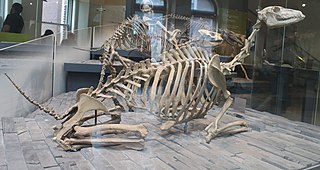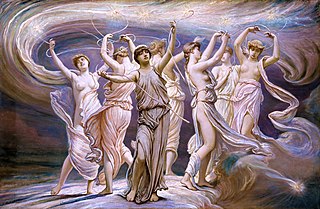The Baptes were priests of the Greek goddess Kotys. The word comes from the Greek verb βάπτω (baptō), meaning "to dip in water". The Baptes practised nocturnal ceremonies, which were associated with rampant obscenity and insobriety.
In Greek mythology, Eiresione or Iresione was the personification of an object very important in many Greek rituals and ceremonies: a branch of olive or laurel, covered with wool, fruits, cakes and olive flasks, dedicated to Apollo and carried about by singing boys during the festivals of Pyanopsia and Thargelia, and afterwards hung up at the house door. It could only be carried by children who had two living parents. The song they were singing during the ritual was also known as "eiresione":
Eiresione for us brings figs and bread of the richest,
brings us honey in pots and oil to rub off from the body,
Strong wine too in a beaker, that one may go to bed mellow.

In Greek mythology, an Oread or Orestiad is a mountain nymph. Oreads differ from each other according to their dwelling: the Idaeae were from Mount Ida, Peliades from Mount Pelion, etc. Myths associated the Oreads with Artemis, since the goddess, when she went out hunting, preferred mountains and rocky precipices.
Onomastics is the study of proper names, including their etymology, history, and use.

Petroselinum is a genus of two parsley species of flowering plants in the family Apiaceae, native to western and southern Europe and northern Africa.
Nepenthe is a possibly fictional medicine for sorrow – a "drug of forgetfulness" mentioned in ancient Greek literature and Greek mythology, depicted as originating in Egypt.
Ancient Greek philosophy differentiates main conceptual forms and distinct words for the Modern English word love: agápē, érōs, philía, philautía, storgē, and xenía.

A Greek–English Lexicon, often referred to as Liddell & Scott or Liddell–Scott–Jones (LSJ), is a standard lexicographical work of the Ancient Greek language originally edited by Henry George Liddell, Robert Scott, Henry Stuart Jones, and Roderick McKenzie and published in 1843 by the Oxford University Press.
Robert Scott was a British academic philologist and Church of England priest. He is best known for co-authoring the Greek-English Lexicon, commonly known as Liddell and Scott, which is still in use today. Scott was also a professor of Greek at the University of Oxford for over thirty years before his death on 2 December 1887.
Ancient Greek units of measurement varied according to location and epoch. Systems of ancient weights and measures evolved as needs changed; Solon and other lawgivers also reformed them en bloc. Some units of measurement were found to be convenient for trade within the Mediterranean region and these units became increasingly common to different city states. The calibration and use of measuring devices became more sophisticated. By about 500 BC, Athens had a central depository of official weights and measures, the Tholos, where merchants were required to test their measuring devices against official standards.

Aepycamelus is an extinct genus of camelids that lived during the Miocene 20.6–4.9 million years ago, existing for about 15.7 million years. Its name is derived from the Homeric Greek αἰπύς, "high and steep" and κάμηλος – "camel"; thus, "high camel"; alticamelus in Latin.

Camelops is an extinct genus of camel that lived in North and Central America, ranging from Alaska to Honduras, from the middle Pliocene to the end of the Pleistocene. It is more closely related to living camels than to lamines, making it a true camel of the Camelini tribe. Its name is derived from the Ancient Greek κάμηλος and ὄψ, i.e. "camel-face".

Procamelus is an extinct genus of camel endemic to North America. It lived from the Middle to Late Miocene 16.3—5.3 mya, existing for approximately 11 million years. The name is derived from the Greek πρό, meaning "before" or denoting priority of order, and κάμελος ("camel"), thus meaning "fore-camel", "early camel" or "predecessor camel".

Poebrotherium is an extinct genus of camelid, endemic to North America. They lived from the Eocene to Miocene epochs, 46.3—13.6 mya, existing for approximately 32 million years.

Alcyone, in Greek mythology, was the name of one of the Pleiades, daughters of Atlas and Pleione or, more rarely, Aethra. She attracted the attention of the god Poseidon and bore him several children, variously named in the sources: Hyrieus, Hyperenor, and Aethusa; Hyperes and Anthas; and Epopeus. By a mortal, Anthedon, Alcyone became the mother of the fisherman Glaucus, who was later transformed into a marine god.

Amyntas is a male given name, a variation of ἀμύντης (amyntes), derived from the Ancient Greek: ἀμύντωρ (amyntor) 'defender, helper' and ultimately from the verb ἀμύνω 'to ward off, to defend'. It was particularly widespread in ancient Macedon, and was given to several prominent ancient Macedonian and Hellenistic figures. It later became a stock name for lovelorn shepherds in 16th-century pastoral literature.

Hemiauchenia is a genus of laminoid camelids that evolved in North America in the Miocene period about 10 million years ago. This genus diversified and entered South America in the Late Pliocene about 3-2 million years ago, as part of the Great American Biotic Interchange. The genus became extinct at the end of the Pleistocene. The monophyly of the genus has been considered questionable, with phylogenetic analyses finding the genus to paraphyletic or polyphyletic, with some species suggested to be more closely related to living lamines than to other Hemiaucenia species.

Hesperostipa is a genus of grasses in the family Poaceae. Members of the genus are commonly known as needle-and-thread grass or needlegrass.

Asterope was a Hesperid in Greek mythology.











